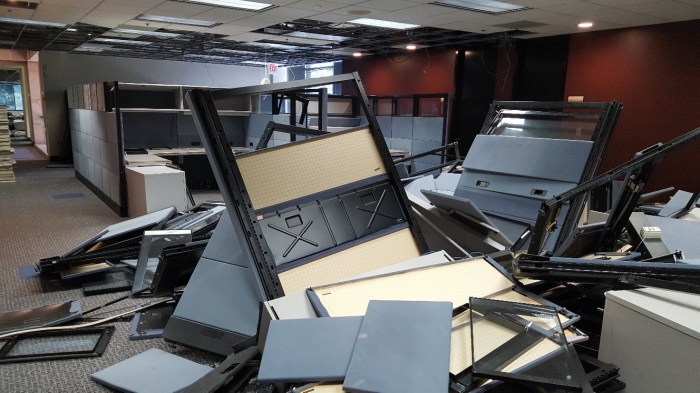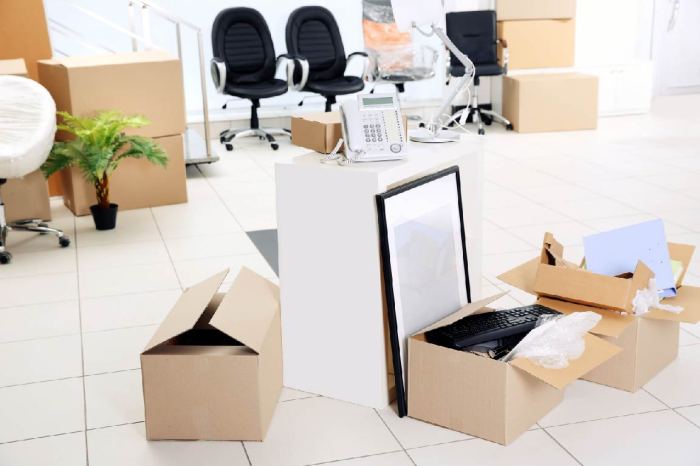Embarking on the task of office furniture removal, we delve into a comprehensive guide that unravels the intricacies of this essential process. From meticulous planning to eco-friendly disposal, we explore the nuances of office furniture removal, empowering you with the knowledge to execute this task seamlessly.
As we navigate the complexities of office furniture removal, we uncover the diverse range of services available, catering to the unique needs of every organization. Understanding the various methods employed for efficient removal, we delve into the importance of safety, liability concerns, and cost considerations.
By equipping you with a comprehensive understanding of office furniture removal, we empower you to make informed decisions and ensure a smooth and successful process.
Office Furniture Removal Services
Office furniture removal services provide a comprehensive solution for businesses and organizations looking to dispose of their old or unwanted office furniture. These services encompass a wide range of tasks, ensuring a seamless and efficient removal process.
The scope of office furniture removal services typically includes:
- Removal of desks, chairs, cubicles, and filing cabinets
- Disassembly and reassembly of furniture as needed
- Packing and transportation of furniture to designated disposal or recycling facilities
Office furniture removal services cater to the removal of various types of office furniture, including:
- Desks: Traditional desks, executive desks, computer desks, and more
- Chairs: Office chairs, ergonomic chairs, task chairs, and more
- Cubicles: Modular cubicles, workstation cubicles, and more
- Filing cabinets: Lateral filing cabinets, vertical filing cabinets, and more
To ensure efficient and safe removal, office furniture removal services employ various methods, including:
- Manual removal: Involves physically carrying and lifting furniture items
- Machine-assisted removal: Utilizes equipment such as forklifts and pallet jacks for heavy or bulky items
- Specialized techniques: Used for delicate or valuable items, such as packing in protective materials and using specialized equipment
Planning and Preparation for Office Furniture Removal
Effective office furniture removal requires meticulous planning and preparation. By establishing a comprehensive removal plan, coordinating resources, and preparing the removal site, businesses can ensure a smooth and efficient process that minimizes disruptions and ensures the safety of their assets.
Creating a Detailed Removal Plan
A well-defined removal plan is crucial for successful execution. This plan should Artikel the following:
-
-*Timelines
Establish clear timelines for each phase of the removal process, including packing, loading, transportation, and unloading.
-*Resource Allocation
Determine the personnel, equipment, and vehicles required for the removal and allocate them accordingly.
-*Contingency Measures
Identify potential challenges and develop contingency plans to mitigate any unexpected delays or issues.
Inventorying and Labeling Office Furniture
Accurate inventorying and labeling of office furniture is essential for efficient removal and tracking. This involves:
-
-*Inventorying
Create a detailed inventory of all furniture items, including their dimensions, condition, and location.
-*Labeling
Assign unique labels to each furniture item for easy identification during packing and unloading.
Preparing the Removal Site
Preparing the removal site ensures a safe and efficient process. This includes:
-
-*Clearing Pathways
Ensure that all pathways for furniture removal are clear of obstacles and debris.
-*Protecting Floors
Cover floors with protective materials to prevent damage during removal.
-*Providing Adequate Lighting
Ensure sufficient lighting for the removal team to work safely and efficiently.
Environmental Considerations in Office Furniture Removal
In today’s environmentally conscious landscape, it is imperative to consider the ecological implications of office furniture removal. Sustainable practices must be prioritized to minimize the negative impact on our planet.
Recycling and repurposing used office furniture offer viable alternatives to disposal. Organizations specializing in these services can facilitate the donation or sale of gently used items, extending their lifespan and reducing waste. Responsible waste disposal is equally crucial, ensuring that materials are disposed of in an environmentally friendly manner, minimizing landfill contributions.
Recycling and Repurposing
Recycling office furniture involves breaking down materials like wood, metal, and fabric into reusable components. This process conserves natural resources, reduces energy consumption, and decreases greenhouse gas emissions. Repurposing, on the other hand, involves transforming used furniture into new items, extending its utility and reducing waste.
Responsible Waste Disposal
Landfills are a major source of environmental pollution. Proper waste disposal practices are essential to minimize their impact. Office furniture that cannot be recycled or repurposed should be disposed of responsibly, adhering to local regulations and environmental standards. This includes proper sorting, segregation, and disposal methods to prevent harmful materials from entering landfills.
Safety and Liability Concerns in Office Furniture Removal

Ensuring safety and mitigating liability concerns are paramount in office furniture removal operations. Adhering to proper lifting techniques, utilizing personal protective equipment (PPE), and identifying potential hazards are crucial to prevent accidents and injuries.
Lifting Techniques
Proper lifting techniques are essential to avoid strain or injury. Always lift with your legs, not your back. Keep your back straight, bend your knees, and lift smoothly without jerking.
Office furniture removal can be a daunting task, especially if you’re not sure how to handle heavy items. One question that often comes up is whether or not to tip furniture delivery workers. Do we tip furniture delivery ? While tipping is not mandatory, it’s a common practice to show appreciation for their hard work.
Back to office furniture removal, it’s important to plan ahead and consider the size and weight of your furniture, as well as the distance it needs to be moved.
Personal Protective Equipment (PPE)
Wearing appropriate PPE is crucial for protecting yourself from potential hazards. This includes sturdy work gloves to prevent cuts and bruises, safety glasses to shield your eyes from flying debris, and a hard hat to protect your head from falling objects.
Hazard Identification
Identifying potential hazards before starting the removal process is essential. Look for tripping hazards like cords or loose carpets, slippery surfaces, or unstable furniture. Remove or secure any hazards to create a safe work environment.
Liability Considerations
Having adequate insurance coverage is essential to mitigate potential liability risks. Consider general liability insurance to protect against claims of property damage or personal injury. Additionally, workers’ compensation insurance provides coverage for employees who may sustain injuries during the removal process.
Office furniture removal can be a daunting task, especially if you have a large amount of furniture to move. Fortunately, there are professional office furniture movers who can help you with this task. These movers have the experience and equipment necessary to move your furniture safely and efficiently.
They can also help you with packing and unpacking your furniture, so you can focus on other aspects of your move. Whether you’re moving to a new office or just rearranging your current one, office furniture removal is a job that’s best left to the professionals.
Risk Management Strategies
Implementing risk management strategies can further reduce liability concerns. Train employees on proper lifting techniques and hazard identification. Regularly inspect equipment and ensure it is in good working order. Establish clear protocols for handling heavy or fragile items.
Cost Considerations and Budgeting for Office Furniture Removal

Office furniture removal involves various cost factors that impact the overall budget. Understanding these costs and the pricing models used by removal companies is crucial for effective planning and optimization.
Labor Costs
Labor costs account for a significant portion of the removal expenses. The number of movers required, the complexity of the removal process, and the duration of the job influence labor costs. Hourly rates or flat fees may apply.
Equipment Costs
Specialized equipment, such as dollies, forklifts, and lifting straps, may be necessary for efficient furniture removal. Rental or purchase of this equipment adds to the overall cost.
Transportation Costs
The distance between the origin and destination, the size of the moving truck required, and fuel expenses contribute to transportation costs. Companies may charge flat rates or mileage-based fees.
Disposal Fees
Disposing of unwanted furniture responsibly incurs additional costs. Landfill fees, recycling charges, or donations to charities may apply. Exploring cost-saving measures, such as recycling or donating reusable items, can help reduce disposal expenses.
The arduous task of office furniture removal can be made easier with the right tools and equipment. If you’re looking for high-quality office furniture, consider matrix furniture . Their ergonomic designs and durable construction ensure comfort and longevity. Whether you’re relocating or simply refreshing your workspace, matrix furniture offers a wide range of options to suit your needs.
Their commitment to quality and customer satisfaction makes them a reliable choice for office furniture removal.
Choosing the Right Office Furniture Removal Company

When relocating or remodeling an office, selecting a reputable office furniture removal company is crucial. Here are key criteria to evaluate:
- Experience:Look for companies with a proven track record in office furniture removal, preferably with references from satisfied clients.
- 资质认证:Check if the company holds industry certifications, such as ISO 9001 or BIFMA Level 3, which demonstrate their commitment to quality and safety standards.
- Customer Reviews:Read online reviews from previous clients to gauge the company’s reliability, responsiveness, and attention to detail.
- Insurance Coverage:Ensure the company has adequate liability and workers’ compensation insurance to protect your assets and their employees.
To ensure the best value for money, it’s advisable to obtain multiple quotes and compare services. Consider factors such as the scope of work, the company’s reputation, and the overall cost. By carefully evaluating these criteria, you can choose an office furniture removal company that meets your specific needs and provides a seamless and professional experience.
Post-Removal Considerations and Follow-Up
The post-removal process is just as important as the removal itself. It involves cleaning and restoring the removal site, ensuring proper waste disposal, and following up with clients to ensure satisfaction.
Cleaning and Restoration, Office furniture removal
After the furniture has been removed, it’s important to clean the area thoroughly. This includes sweeping, mopping, and dusting. If necessary, you may also need to repair any damage to the walls or floors.
Waste Disposal
Any waste generated during the removal process must be disposed of properly. This includes cardboard boxes, packing materials, and old furniture. You should check with your local waste management company to find out what their regulations are for disposing of these items.
Follow-Up with Clients
Once the removal is complete, it’s important to follow up with clients to ensure satisfaction. This can be done via phone call, email, or in person. During the follow-up, you should ask the client if they have any questions or concerns.
You should also take this opportunity to thank them for their business.
Last Word
In conclusion, office furniture removal is a multifaceted process that demands careful planning, attention to environmental sustainability, and adherence to safety protocols. By embracing the insights and strategies Artikeld in this comprehensive guide, you can effectively manage the removal of your office furniture, ensuring a seamless transition and minimizing disruption to your operations.
Remember, a well-executed office furniture removal not only enhances the aesthetics of your workspace but also contributes to a more sustainable and efficient work environment.
Essential Questionnaire
What factors should be considered when choosing an office furniture removal company?
When selecting an office furniture removal company, it is crucial to evaluate their experience,资质认证, customer reviews, and insurance coverage. Additionally, obtaining multiple quotes and comparing services will help you secure the best value for your money.
What are the key steps involved in planning and preparing for office furniture removal?
Effective planning and preparation for office furniture removal involve creating a detailed removal plan with timelines, resource allocation, and contingency measures. Inventorying and labeling office furniture, as well as preparing the removal site for efficient execution, are also essential steps to ensure a smooth process.
How can I ensure the safe and efficient removal of heavy or delicate office furniture items?
For heavy or delicate office furniture items, specialized removal techniques are often required. Professional removal companies possess the expertise and equipment to handle these items safely and efficiently, minimizing the risk of damage or injury.